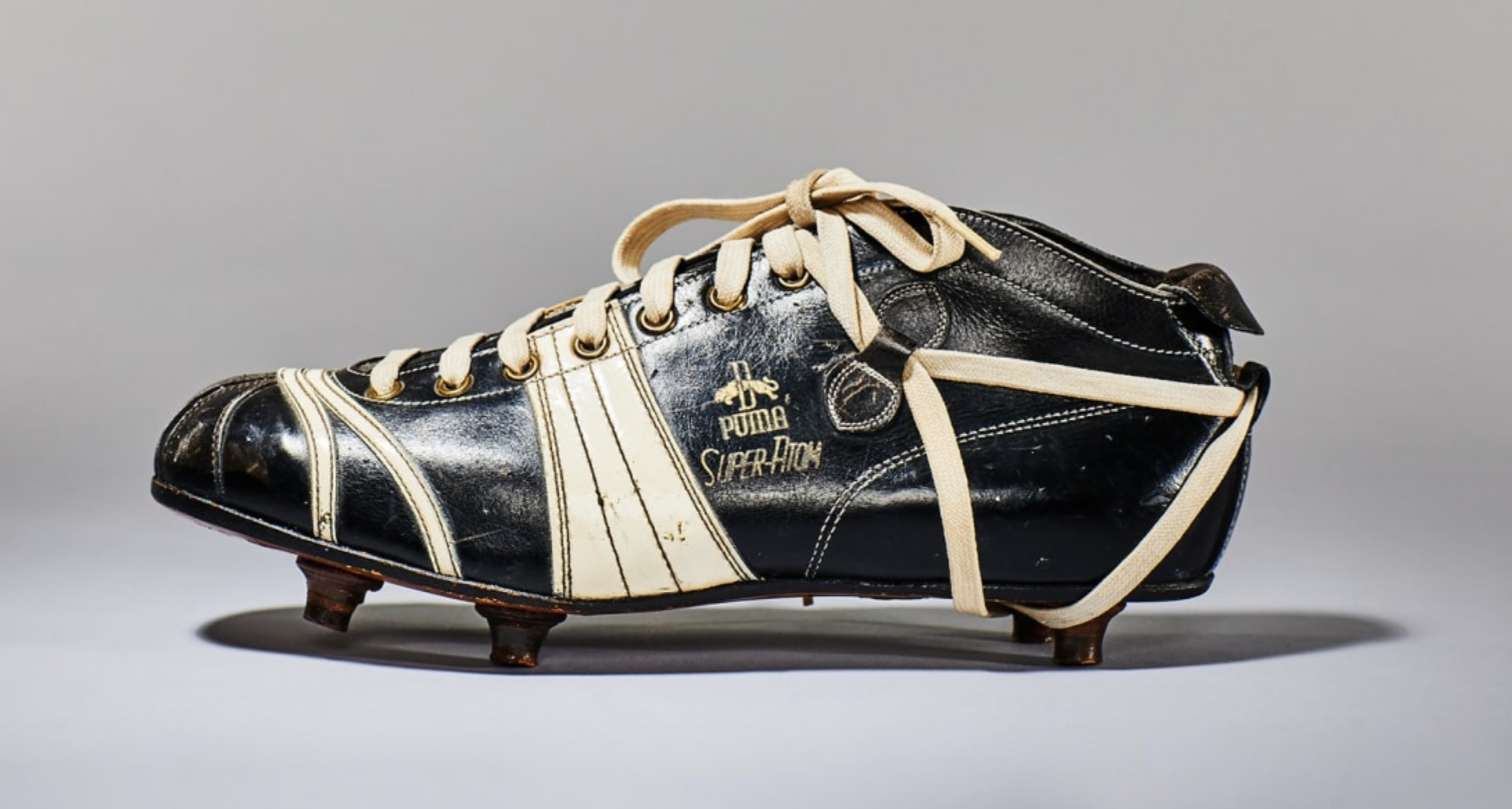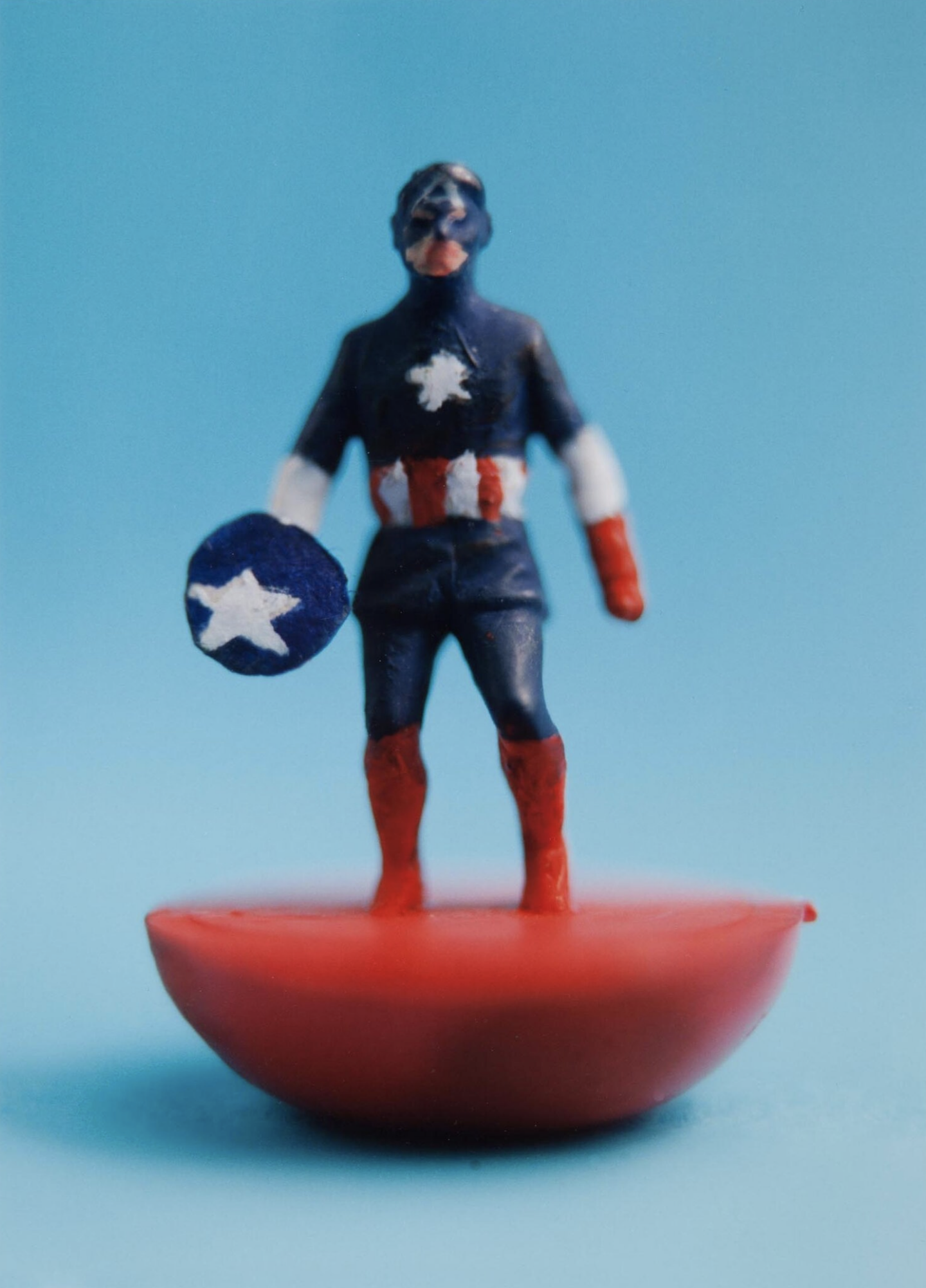Designing the Beautiful Game: Play Better, Look Better, Earn Better
Photo credit: Puma archive
'Behind every kick of a ball, there has to be a thought.’
Denis Bergkamp
I recently visited an excellent exhibition exploring the role of design in the development of football. (‘Football: Designing the Beautiful Game’ is at the Design Museum, London until 29 August.)
On entering the gallery you encounter a Zambian ball made from a maize meal sack tied with string. It serves to reinforce the simplicity of the game that has made it so broadly popular.
'One of the reasons football is the most popular sport in the world is because the weak can beat the powerful.’
Marcelo Bielsa
You can see displays of historic balls, boots, banners and badges; archaic shinpads, pumps and goalkeepers’ gloves; the Acme Thunderer, the world’s original sport whistle, invented by a Birmingham toolmaker in 1884.
You can admire George Best’s first pair of boots – on the sides, in neat white painted letters, he recorded the games in which he scored. You can marvel at number 10 shirts worn by Platini, Messi, Zico and Maradonna.
'It’s true I don’t know much about the players here, but they definitely know who I am.’
Zlatan Ibrahimovic (on joining PSG in 2012.)
You can learn that the iconic Brazilian strip, incorporating the four colours of the national flag, was designed by an 18 year old newspaper illustrator. He was responding to a competition after the humiliating loss to Uruguay in the 1950 World Cup Final, when the team wore an all-white kit.
You can observe design’s impact beyond the pitch: from a rudimentary rattle to the reviled vuvuzela horn; from promotional posters to match day programmes and fanzines. There’s Coventry’s splendid Sky Blue programme, which won a D&AD prize in 1972. There are displays about innovative stadium architecture: the San Siro, the Allianz Arena, Tottenham Hotspur and Forest Green Rovers.
I noted with a pang of melancholy that Spurs’ sophisticated acoustic modelling has not been applied at West Ham’s London Stadium. Indeed, as far as I could see, the Hammers’ main contribution to the exhibition was a hooligan calling card…
One of the two match balls used in the 1930 World Cup final, supplied by Argentina and used in the first half. Credit: Neville Evans Collection
'Before you can coach others, you must learn to coach yourself.’
Johan Cruyff
Football has been so popular that from the early days there were games based on the game. The oldest version of table football was manufactured in Preston in 1884. Then came blow football, Subbuteo and on through to today’s videogames. I enjoyed spotting a couple of photographs, by Julian Germain, of Superhero Subbuteo figures that were painted by BBH’s magnificent copywriter Nick Kidney.
'Football is the ballet of the masses.’
Dmitri Shostakovich
I was particularly struck by the way that, over the years, design has moved football forward in small increments.
You can trace the development of shirt construction from collared flannelette to crewneck cotton to high tech elastane - lightweight, breathable and sweat-wicking.
'In football everything is complicated by the presence of the opposite team.'
Jean-Paul Sartre
You can see how the design of footballs progressed: from heavy spheres made with an animal bladder wrapped in thick leather, to panelled balls with large seams. In 1931 the Argentine Superball, inflated using an air valve, dispensed with the leather lace, thus making it easier to head. 1974’s adidas Telstar, comprising 32 panels of white hexagons and black pentagons, was conceived to be more visible on TV. Subsequent balls, made with thermally bonded synthetic panels, have sought to deliver better boot contact and ‘truer flight.’
Note how new technology has changed the game itself, making it faster, more fluid and more skilful. Note too how in recent years marketing has moved the focus onto commercial optimisation.
'I wouldn’t say I was the top manager in the business, but I would say I was in the top one.’
Brian Clough
Designing the new Brazilian kit. Courtesy of Felix Speller
Consider the evolution of the boot.
The first footballers wore high-cut, leather work-shoes. By the 1880s players were nailing studs onto their soles to give secure footing on soft ground. Soon the footwear had reinforced toes and ankles. Manufacturers recognised the power of player endorsement to sell boots to a broader public. In the early 1900s MJ Rice & Son launched Steve Bloomer’s Lucky Goal Scorers. In the 1930s a lower cut, lighter boot, more suited to drier conditions and dribbling, was developed in southern Europe and South America. This ‘Continental’ style was adopted by Stanley Matthews, who in the early ‘50s promoted a pair for the mass market in collaboration with the Coop.
'We don’t want our players to be monks. We want them to be better football players, because a monk does not play football at this level.’
Bobby Robson
In 1952 the Puma Super Atom became the first boot with screw-in studs. West Germany were losing the 1954 World Cup Final 2-0 at half-time to favourites Hungary. Adi Dasler (the founder of adidas and brother of Puma founder Rudolf) suggested fitting the team’s boots with longer studs more appropriate to the rain-soaked conditions. West Germany went on to win 3-2 and the match was dubbed the ‘Miracle of Bern.’
'Football is a simple game. Twenty-two men chase a ball for 90 minutes and at the end the Germans always win.'
Gary Lineker
No. 2 Captain America aka Steve Rogers, Full Back. Figure by Nick Kidney / photo by Julian Germain
The 1968 Puma King featured a flexible sole and lightweight nylon screw studs. In 1970 Alan Ball wore boots painted white by Hummell, the first soccer footwear to be neither black nor brown. Subsequently, as pitch conditions improved and the need for protection diminished, boots were given lightweight kangaroo and textile uppers. There are now laceless models to enable a cleaner strike.
'Everything I know about morality and the obligations of men, I owe it to football.’
Albert Camus
It seems clear that football’s progress was driven by a combination of performance enhancement, scientific invention and commercial ingenuity. Marketing expanded the focus beyond the elite players on the pitch, to the broader playing community and indeed to non-playing spectators.
Design helped football and footballers play better, look better, earn better.
'Aim for the sky and you’ll hit the ceiling. Aim for the ceiling and you’ll stay on the floor.’
Bill Shankly
Of course, sometimes design and marketing have gone too far. Their voices have become too powerful. Too many unnecessary strips, unconvincing endorsements and uncalled for innovations have tested fans’ loyalty.
When the adidas Jabulani was introduced at the 2010 World Cup to a corporate fanfare, players complained that it had unpredictable movement. In 1995 the majority of Premier League club sponsors came from the technology and telecom sectors. In 2010 they came from financial services. By 2021 it was mostly betting. And when in 2013 Hull City's owners proposed changing the club's name to Hull City Tigers, supporters staged a protest with a banner proclaiming 'a club, not a brand.'
Designers and marketers need to remind themselves that, as Jock Stein said:
‘Football without fans is nothing.’
'In the marble halls of the charm school
How flair is punished.
Under marble Millichip, the FA broods
On how flair can be punished.
Their guest is a Euro-state magnate
Corporate-ulent.
How flair is punished.
Kicker, kicker conspiracy.
Kicker, kicker conspiracy.’
The Fall, ‘Kicker Conspiracy’ (M Smith)
No. 373



